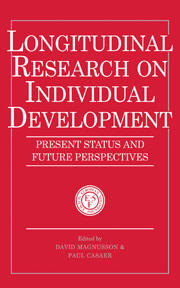Book contents
- Frontmatter
- Contents
- List of principal contributors
- Foreword
- Preface
- 1 Human ontogeny: a longitudinal perspective
- 2 Genes, experience and development
- 3 The human brain and longitudinal research in human development
- 4 Longitudinal research and a biology of human brain development and behaviour
- 5 Cognitive, social and emotional development
- 6 Developmental psychopathology: some historical and current perspectives
- 7 Developmental psychopathology as a research perspective
- 8 Longitudinal research on human aging: the power of combining real-time, microgenetic and simulation approaches
- 9 Development, aging and control: empirical and theoretical issues
- 10 Some methodological issues in longitudinal research: looking ahead
- Index
6 - Developmental psychopathology: some historical and current perspectives
Published online by Cambridge University Press: 22 March 2010
- Frontmatter
- Contents
- List of principal contributors
- Foreword
- Preface
- 1 Human ontogeny: a longitudinal perspective
- 2 Genes, experience and development
- 3 The human brain and longitudinal research in human development
- 4 Longitudinal research and a biology of human brain development and behaviour
- 5 Cognitive, social and emotional development
- 6 Developmental psychopathology: some historical and current perspectives
- 7 Developmental psychopathology as a research perspective
- 8 Longitudinal research on human aging: the power of combining real-time, microgenetic and simulation approaches
- 9 Development, aging and control: empirical and theoretical issues
- 10 Some methodological issues in longitudinal research: looking ahead
- Index
Summary
INTRODUCTION
Developmental psychopathology has been described as an ‘emergent discipline’ (Cicchetti, 1984) one ‘truly … born over the past five years’ (Zigler, 1989). What characterizes this newcomer that seeks an integration of the developmental and clinical sciences? Many characterizations have been offered, (Lewis & Miller, 1990) and these vary in complexity and coverage. On the side of simplification are the offerings of Achenbach (1990) (‘ … a general approach to understanding relations between development and its maladaptive deviations’) and Lewis (1990) (‘ … the study of the prediction of maladaptive behavior and processes.’)
Two definitions provide a better offering given the complexity of this growing arena of research. One has been provided by Sroufe & Rutter (1984) in a seminal article on The domain of developmental psychopathology in which they present both a definition and the boundaries of the field from their perspective as developmental researchers/theorists:
The very name of the discipline provides a starting point for defining the scope and particular quality of this field. First, it is concerned with development and is therefore closely wedded to the whole of developmental psychology. The methods, theories, and perspectives of developmental psychology are important tools of inquiry. Second, the focus is on pathology, that is developmental deviations. Developmental psychopathology may be defined as the study of the origins and course of individual patterns of behavioral maladaptation, whatever the age of onset, whatever the causes, whatever the transformations in behavioral manifestation, and however complex the course of the developmental pattern may be.
(p. 18)- Type
- Chapter
- Information
- Longitudinal Research on Individual DevelopmentPresent Status and Future Perspectives, pp. 95 - 126Publisher: Cambridge University PressPrint publication year: 1993
- 5
- Cited by



